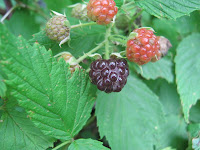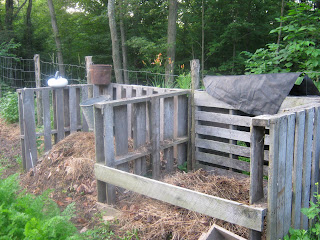Mike has mushrooms available for sale! He has a patch of wine cap mushrooms growing in our lower garden space. A couple of months ago he laid down a layer of hardwood chips, spread the mushroom "stuff" on it and then placed a layer of wet straw on top of that. There are now white thread like mycilium in the layers and the wine caps are growing from that.
He had a small battle with slugs, but seems to have figured that out. There is now a moat of wood ashes around the patch. For the most part the slugs have been deterred.
The Wine Caps will be for sale at the Potsdam Farmer's Market at Deep Root Farm's stand. Deep Root CSA share holders, please let us know if you are interested in purchasing some mushrooms.
Next year, he will have shitake and oyster mushrooms available. They are growing in logs in our woods. The spores need to inoculate the logs and by late summer, next year they will be ready.
Here is some more wine cap info and a recipe:
Stropharia rugosoannulata (Wine Cap)
Delicious and often enormous, the Wine Cap pops up commonly in the hardwood woodchips used in landscaping mulch around trees and along tended pathways. This mushroom can be identified positively only in the presence of both the young and mature specimens. The buttons are sometimes but not always a Burgundian red wine color on top. When the veil is still closed over the immature gills, there is a coglike star pattern around the stem. In the mature fruiting bodies, the gills change from pink to a dark pinkish grey to grey brown color while the color of the cap lightens to a light brown to beige color. The spore print is purplish black in color.
I recommend eating only the young mushrooms of this species which are firm and bug free. The buttons of this species can reach 5-6” in diameter while still immature. They are meaty and rich and are well paired in meat sauces and sautés. When large, it can be cut into strips, brushed with olive oil, balsamic vinegar, sprinkled with herbs, salt and pepper and grilled to perfection.
Wine caps and cauliflower
Here's a side dish where the mild flavor of cauliflower offsets the stronger influences of the wild mushrooms and Indian seasonings. Wine-cap stropharia mushrooms have enough of a penetrating flavor to withstand the pungent spices.
2 tablespoons peanut oil
2 teaspoons garam masala or curry powder
1 teaspoon black mustard seeds
1 teaspoon cumin seeds
1/2 teaspoon freshly ground black pepper (1/4 teaspoon peppercorns)
1 clove garlic, chopped
1 1/2 pounds cauliflower, broken into florets
2 1/2 cups sliced wine-cap stropharia mushrooms
1. Heat the peanut oil in a large skillet over medium heat. Add the garam masala, black mustard seeds, cumin seeds, and black pepper and cook, stirring constantly, until the mustard seeds pop, 2 to 3 minutes.
Add the remaining ingredients and cook the vegetables, stirring, for another 15 minutes, until the water from the mushrooms has evaporated.
Spiced Wine Caps
8 cups wine cap stropharia mushrooms, sliced
1 tsp. almond oil or canola oil
2 tsp. water mint or other mint species, ground
1/2 tsp. nutmeg, ground
1 tsp. cardamon, ground
1 tsp. anise seeds, ground
1 tsp. salt
2 tbs. wineberry wine or red wine
1. Heat the oil in a frying pan, add the mushrooms, and add the mushrooms, spices, and salt.
2. Cook on medium heat 5 minutes, stirring often.
When the mushrooms release liquid, add the wine and continue cooking another 10 minutes or until all the liquid is absorbed or evaporated, stirring often.
Wine Caps in Wine
12 cups wine cap stropharia mushrooms, sliced
1/2 tbs. olive oil
6 tbs. lemon juice or lime juice
6 tbs. oak leaf wine or white wine
1/2 tbs. nutmeg, ground
1/2 tbs. fennel seeds, ground
1/2 tbs. salt
1. Cook the mushrooms in the olive oil over medium heat 3-5 minutes or until they begin to release liquid.
2. Stir in the remaining ingredients and bring to a boil. Reduce the heat to low, cover, and simmer over low heat 15 minutes.
Uncover and cook over high heat, stirring constantly, until all the liquid is evaporated or absorbed, about 5-10 minutes.








